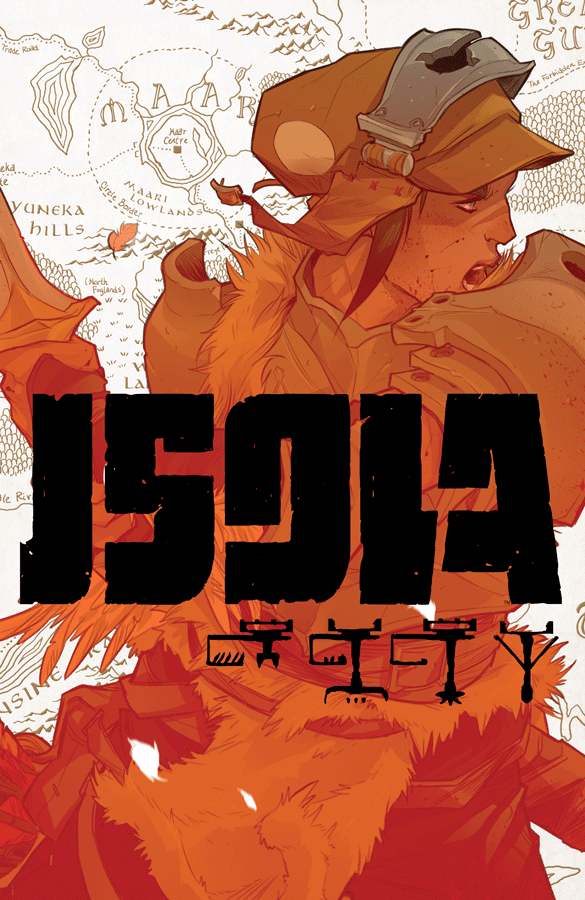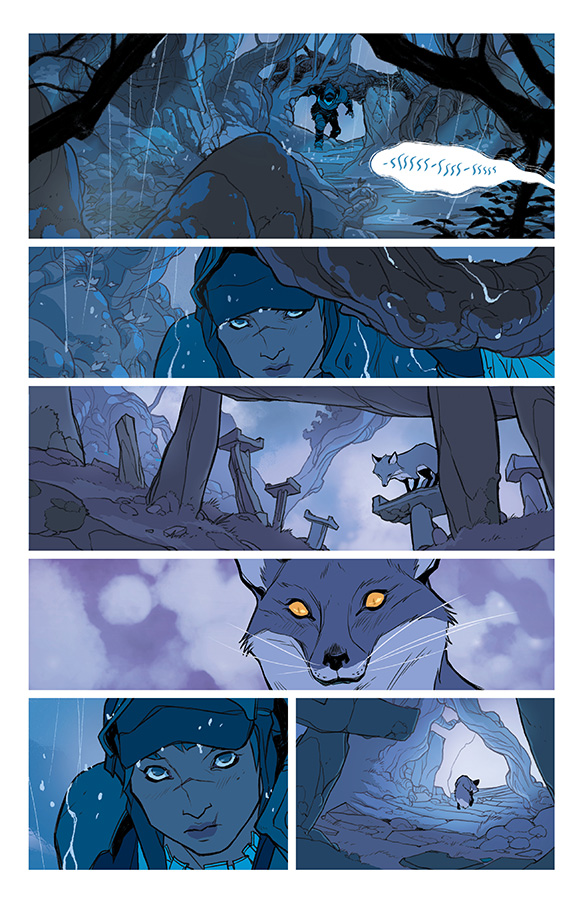By Brendan F. Hodgdon. There were a bunch of cool books announced at Image Expo 2016, and out of all of those announcements from 2 years ago the one that commanded the majority of my interest was Isola, a beautiful-looking and exciting-sounding new series from Gotham Academy alums Brenden Fletcher and Karl Kerschl. Now, after a long wait, that series is finally here. And while I’m comfortable saying the series has already proven itself to be worth the wait, I’m just as comfortable saying that it’s not exactly what I was expecting.
More specifically, Isola represents a slowed-down, decompressed sort of storytelling, and so reading it requires adjusting your expectations somewhat. This is not a series beholden to the exposition-heavy, start-with-a-bang structure that we tend to get from first issues; Fletcher and Kerschl attempt to draw you into their world in a more understated fashion that requires an active engagement from the reader.
For those of you willing to engage with Isola on its own terms, you will ultimately find the same elements that made Fletcher and Kerschl’s Gotham Academy (not to mention Fletcher’s other great work) stand out: strong, relatable women, challenging emotions, and wonderful art. In that regard, Isola is exactly the book I was looking forward to back in 2016.
$3.99/Image Comics
Written by Brenden Fletcher and Karl Kerschl.
Illustrated by Karl Kerschl and Msassyk.
Letters by Aditya Bidikar.
Royal pains. In this first issue, the dramatic tension that holds everything together is the relationship between neophyte knight Rook and the neon-blue tiger that was once her queen, Olwyn. Rook’s inexperience and jitters make her a live wire, potentially as much a threat to Olwyn as any of the bandits or beasts that they encounter, while Olwyn’s animal state makes her unpredictable — and unintelligible — in her own right.
It is the desperation and uncertainty of this relationship that drives the issue forward, and that provides us an emotional lens through which the rest of the story is viewed. While so much of the world and its stakes are left unexplored or only hinted at, it is the relationship between Rook and Olwyn that keeps us invested and engaged.
Collaboration is key. While comics are just as much a visual medium as film or television, and at least as dependent on collaboration, it does seem like a great deal of the critical discussion of comics still boils down to just the writing (I myself am as guilty of this as anyone). But part of what makes Isola so effective is just how much the art is front-and-center, and how much the script relies on the visuals to tell the story.
Considering Fletcher and Kerschl’s history, the effectiveness of this is not surprising in the slightest. Whole pages will go by with no more than five or six words on them, and yet the narrative momentum and the emotional context of the scene is never absent or uncertain. This isn’t a case of a five-page story stretched to twenty-two with an indulgent number of splash pages, but a measured and deliberate progression of beautiful images meant to draw you into this fantasy realm. This is further helped by Msassyk’s evocative colors, which add so much depth and tangibility to the world, and to Aditya Bidikar’s letters, which help sell the emotions that are so essential to this first chapter. The creative team gambled a lot on the art’s ability to carry the story, and it does so with ease.
Quiet time. But while the art-first approach certainly conveys a lot to the reader — a sense of tone and place, the dynamics and emotions between the main characters — it does leave us wondering about the broader narrative stakes surrounding the journey of our heroes.
I would certainly recommend reading the prologue previously collected in Fletcher’s other beautiful Image series Motor Crush (which can now be found on the Isola website), as it provides some fun backstory to the heroes and the world. But there’s still a huge chunk of narrative between the end of the prologue and the beginning of this issue left to be explored. Indeed, the circumstances that have sent Rook and her transmogrified queen are not directly addressed, and even their specific goal is only generally understood.
Instead, Fletcher and Kerschl have chosen to integrate us into their world through the immediate survival of its heroes rather than dump wordy captions on us from the beginning. We are introduced to beasts and hunters and wide-ranging vistas, with only the characters’ reactions to clue us in to what it all means. While this has the potential to be frustrating, it is nice to see storytellers avoid over-indulging their own worldbuilding in favor of emphasizing the moment at hand. It’s a narrative impulse that more storytellers should have.
I hope that everyone will give this issue a shot, even if its approach isn’t your preferred speed. Partially because I have faith Fletcher and Kerschl will pay off this slow build beautifully; partially because the gorgeous look and feel of the series is worth the price of admission alone. But primarily, comics need to be diverse in style and structure and pacing as well as in demographics. The more series like Isola there are out there, the better the medium will ultimately be.
8 out of 10
Brendan Hodgdon is a past winner of the Top Cow Talent Hunt with a comic currently in production at Top Cow, a partner studio of Image Comics.
















